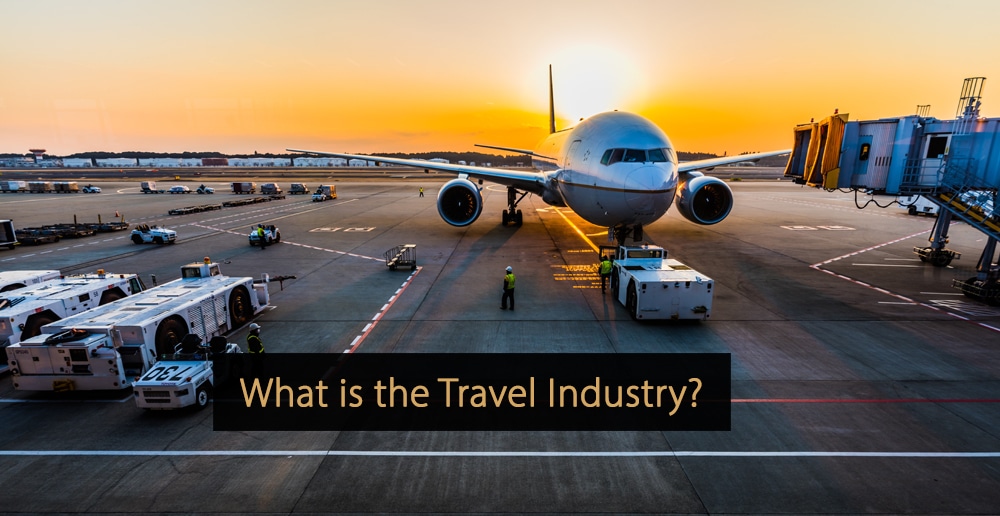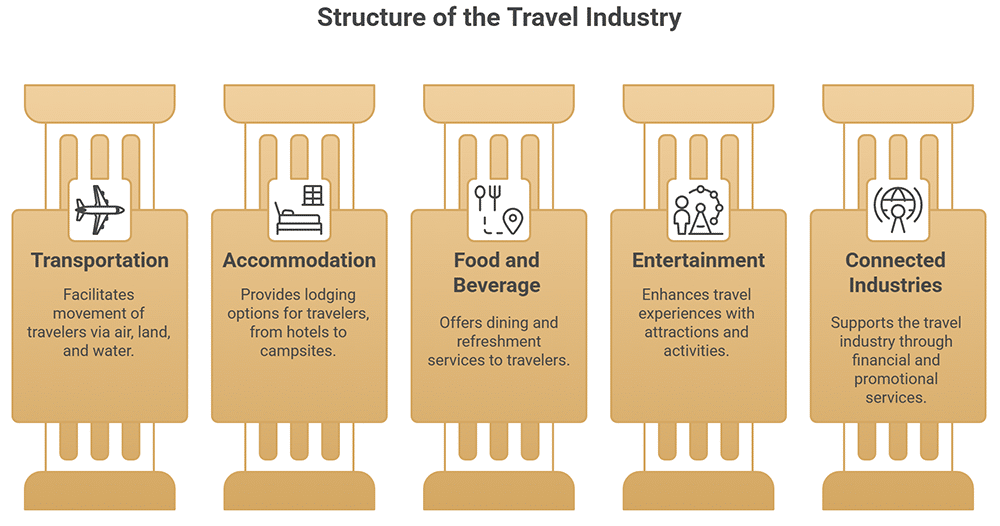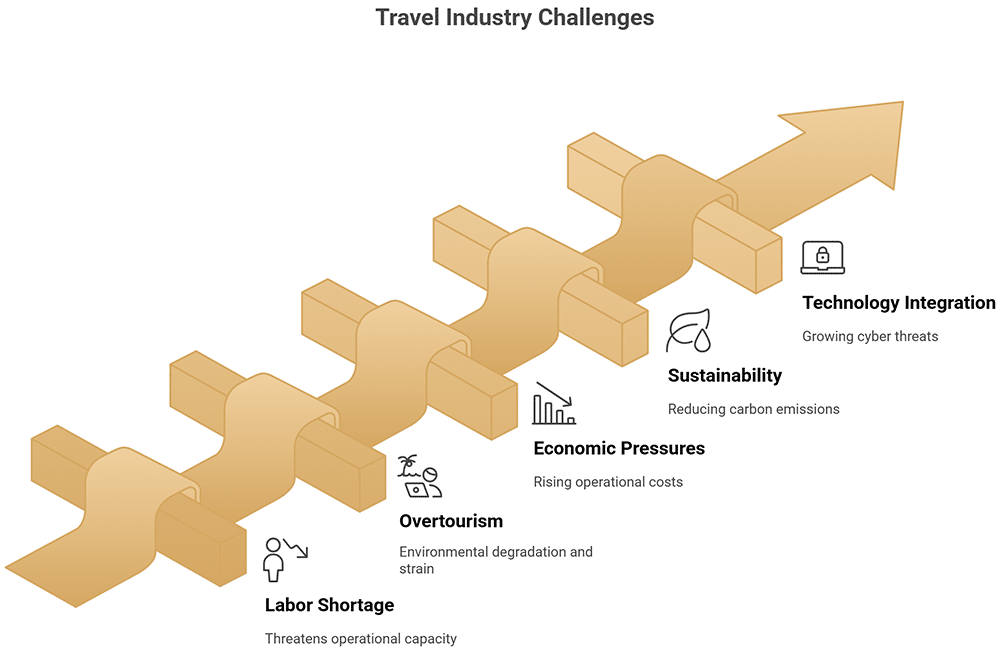The travel industry is one of the largest service industries in the world, an increasingly important one in the modern age. It is centered on the movement of people from one location to another and the services they require along the way. It is closely linked to the hospitality and hotel industries, among others. In this article, you will learn more about what the travel industry is and the various sectors contained within it.
Table of Contents:
- What is the Travel Industry?
- The Difference Between the Travel Industry and the Tourism Industry
- What Sectors and Company Types Operate Within the Travel Industry?
- The Latest Travel Trends
- Technology Trends in the Travel Industry
- The Latest Travel Marketing Tips
- Revenue Management and Its Importance For the Travel Industry
- Economic Size & Impact of Travel Industry
- What You Need to Know About Tourism Management
- Google Travel Insights: Tools and Insights for the Travel Industry
- Operational Challenges in the Travel Industry
- Strategic Recommendations for Hoteliers & Travel Businesses
- Travel Industry Forecasts for the Next Decade (2025-2035)
What Is the Travel Industry?
In simple terms, the travel industry provides services related to travel from one location to another. This includes services directly related to the travel itself, such as transportation, but also includes services related to catering to travelers’ needs and wants after arriving at their destination.
It is often associated with the tourism industry, and, as you will learn later in this article, there is a significant crossover between the two, especially in terms of the businesses that fall under their respective umbrellas.
According to the Global Travel Trends Report, these are the consumer travel habits for 2025:
- 74% of people plan to take between one and three domestic trips in 2025, while 59% intend to take between one and three international trips.
- Experiences are shaping the modern travel industry, with 60% of respondents to the survey saying they intend to book a trip based around sports or entertainment events in 2025.
- Family-friendly destinations offering activities for all age groups were the preferred choice of 81% of respondents.
- Among the Millennial and Gen Z respondents to the survey, 80% said they like the convenience and speed associated with using social media platforms or travel planning apps when making their travel arrangements.
The Difference Between the Travel Industry and the Tourism Industry
According to the Travel & Tourism – Worldwide Report by Statista, the combined travel & tourism market is projected to grow to a market volume of $1,063 billion by 2028, but while the travel and tourism industries are interlinked, it is important to understand that the two have some notable differences. Essentially, the tourism industry relates to the industry centered on tourism, which is the specific act of traveling to a different location, either for business or pleasure.
By contrast, the travel industry is related to a person’s travel from one place to another and the various services they use in that process. In some ways, this means that the travel industry is slightly broader than the tourism industry because it covers many travel purposes and includes trips to non-tourist destinations.
Julia Simpson, WTTC President & CEO, emphasizes the sector’s strength:
“People are continuing to prioritize travel. That’s a powerful vote of confidence in our sector and a sign of its enduring strength. But while tourism is strong, the recovery remains uneven. Whilst some regions are producing record-breaking numbers, other large economies are plateauing.”
Table: Difference Between the Tourism and Travel Industry
What Sectors and Company Types Operate Within the Travel Industry?
The travel industry encompasses multiple sectors. Read about the key players below.
1) Transportation
When they think of the travel industry, many immediately think about transportation and the companies offering transport services. In reality, this is only one sector of the travel industry. Still, it is perhaps the most important, as it centers around facilitating travel from one location to another. Included within this are road, rail, air, and water transportation services, as outlined below:
Airline Industry
The airline industry provides various forms of air travel, including commercial and chartered flights. These flights can be overseas or domestic and cater for relatively short distances, right through to trips to the other side of the world. Different airlines tend to serve specific regions and airports.
The aviation sector is experiencing rapid growth, and this shows no signs of slowing. In fact, current estimates indicate that over the next 20 years, demand for air travel will grow by an average of 4.3% each year.
Car Rental
Car rental plays a key role in the travel industry, providing temporary access to cars and other similar vehicles. According to the Mordor Intelligence report, the car rental market size is estimated at $146.30 billion in 2025, expected to reach $243.76 billion by 2030 at a CAGR exceeding 10.75%. For travelers, the main benefit is the freedom provided via access to a car, as it means the process of getting around is not reliant on scheduled public transport services.
Water Transport
Water transport moves people across water, including rivers, lakes, canals, and oceans. Examples of some of the forms of transport that are included within this category are ocean liners and ferries. Cruises are also included in this, as cruises have a set path, and travel is a fundamental part of the experience.
The global cruise market size is valued at $10.37 billion in 2025, projected to reach $30.8 billion by 2035 at 11.5% CAGR. The industry projects 33.7 million passengers by the end of 2025. Carnival Corporation leads with 48% market share and 100 ships, while Royal Caribbean holds 23% market share with 60 ships.
Coach Services
In many cases, travelers use coach services to travel to their chosen location, which is often more cost-effective than the main alternatives. Coaches also facilitate day trips, while local bus services provide a means for getting around once travelers have arrived at their destination.
Railway
Railways are one of the main ways that people travel domestically, while many rail services also facilitate long-distance international travel. Moreover, underground or subway-style train services tend to provide a convenient way for travelers to get around large cities once they have arrived. The global passenger rail transport market, valued at USD 260.7 billion in 2025, is projected to grow at a CAGR of 7.4%, reaching USD 493.4 billion by 2034, according to Market Research Reports.
Spacecraft
Finally, one of the emerging sub-sections of the transport category of the travel industry relates to spacecraft and commercial space flight. Virgin Galactic is the most well-known example here, with the company aiming to provide space tourism services shortly, allowing customers to travel to outer space.
2) Accommodation
Another vital sector within the travel industry is the accommodation sector. After all, most long-distance travelers will require somewhere to stay overnight. That said, people’s accommodation requirements can vary quite significantly, depending on the length of their stay, the purpose of their journey, the budget they are operating on, the experience they wish to gain, and their personal preferences. According to the Hotel And Other Travel Accommodation Global Market Opportunities And Strategies by Research and Markets, the global hotel and accommodation market is projected to reach $1,453.44 billion by 2031.
Hotels
The hotel and travel industries are closely linked, with hotels being the most popular accommodation for those traveling to a different location and staying overnight. Hotels are establishments that provide access to beds within private rooms. These rooms usually have en suite bathrooms and additional facilities.
The hotel and travel accommodation market is projected to achieve a compound annual growth rate of 6.7%, reaching a market size of over $1,806 billion by 2029, according to the Business Research Company. Big hotel chains are leading the way. For example, Marriott International operates 8,785 properties across 139 countries, while Hilton has 7,530 properties in 123 countries.
Some of the specific factors influencing this growth include an increased willingness to spend on leisure activities, growth in travel among younger generations, rising participation in outdoor activities, and technological advances relevant to the travel industry.
Shared Accommodation
Thanks to the success of services like Airbnb, shared accommodation has emerged as an increasingly popular option for travelers. Through these platforms, guests can find homestay offerings. This may mean having access to a private room in an occupied house or having access to a room shared with other guests.
Hostels
A form of sociable accommodation, hostels provide dorm rooms with multiple beds, and guests effectively pay for a bed rather than a private room. There is a wide range of hostel types, with either mixed or same-sex dormitories, and guests will typically share kitchen, bathroom, and living spaces. According to Grand View Research, the global hostel market size is projected to reach USD 11.04 billion from USD 7.21 billion by 2030, growing at a CAGR of 6.5% from 2024 to 2030.
Camping
Considered a form of outdoor accommodation, camping involves staying overnight in basic shelters, such as a tent. Travelers may spend their time in a commercial campsite, which usually provides additional amenities, or camp in publicly accessible conservation areas, such as national parks. According to Statista, the Camping market worldwide is projected to make a revenue of US$49.60bn in 2025, with an anticipated annual growth rate (CAGR 2025-2030) of 9.46%.
Bed and Breakfast
A bed and breakfast is similar to a hotel in that guests have a private room for overnight stays. However, B&Bs tend to be converted family homes, often with the owners still living there. As the name suggests, breakfast is provided, while a B&B usually has a few rooms. According to the Mordor Intelligence report, the global B&B market stood at USD 32.16 billion in 2025 and is forecast to reach USD 41.50 billion by 2030, reflecting a 5.2% CAGR over the period.
Motels
Motels form an important part of the travel industry. The word itself means ‘motor hotel’, and these properties primarily cater to motorists. They are usually situated along popular routes, will provide on-site parking, and will offer individual rooms for guests, but additional facilities are more limited than with hotels.
Boutique Hotels
A boutique hotel is a design-driven hotel with unique qualities. These hotels will often be extremely trendy and may have a specific theme. Moreover, they are often located within urban areas and will have a relatively small number of rooms. They will often be independent hotels rather than part of wider travel industry chains. According to Market.US research, the Global Boutique Hotel Market size is expected to be worth around USD 50.5 billion by 2034, growing at a CAGR of 7.2% during the forecast period from 2025 to 2034.
Cruises
Aside from being classed as a form of transportation, cruises are also a type of accommodation. After all, guests on cruises will spend most of their time on the ship and will usually be allocated a cabin aboard the ship, where they can relax and sleep.
Farmhouse Accommodation and Agri-Tourism
Agri-tourism is a niche industry that is becoming increasingly popular, with people wishing to get away from their usual environment, spend time on a farm, see the day-to-day activities, and perhaps even take part themselves. Farmhouse accommodation facilitates this and often resembles a bed and breakfast setup. The U.S. agritourism market is projected to grow by 11.4% CAGR from 2023 to 2030, according to Grand View Research. Napa Valley’s wine country and Tuscany’s olive groves are popular examples.
Video: What Is Agritourism?
Time-Share Accommodation
Time-share accommodation refers to a property shared between multiple owners, such as a condo or a holiday home. Ownership rights are split evenly, and usage rights are allocated to each owner for a specific period, meaning every owner gets their time to use the property.
3) Food and Beverage
The food and beverage sector primarily caters to travelers’ basic needs by providing food and drink services. However, it is essential to understand that businesses and services in this category go beyond this primary purpose. Indeed, a huge part of the food and beverage sector is also based on providing travelers with places to relax, enjoy themselves, and/or socialize. The World Food Travel Association (WFTA) has estimated that, on average, visitors spend about 25% of their travel budget on food and beverages.
Restaurants
For most people, restaurants are the most immediately obvious category within the food and beverages sector. Restaurants exist to allow people to enjoy meals that are prepared for them. There is a wide range of restaurant types, from fast-food chains to luxury or family restaurants, all catering to different needs and tastes.
AI technology is playing an ever-increasing role in the restaurant industry, helping to improve customer service and enhance kitchen operations. The restaurant AI segment is experiencing an impressive annual growth rate of 31.61%, according to the Food and Beverage Industry Report 2025 from StartUs Insights. In total, 198 companies are known to be working on restaurant AI technology, and the segment now has a total workforce of 12,600 people, with 1,400 new hires in the previous year.
Catering
Catering refers to providing food and drinks in locations that are more remote or self-contained, with examples of this including entertainment venues, tourist attractions, and parks. In addition, catering services are provided on many forms of transport, including airplanes, trains, and ferries. According to Future Market Insights, the catering management market was worth USD 118.3 billion in 2025, and is predicted to grow to USD 180.3 billion by 2035, with a CAGR of 4.3%.
Fast Food Restaurants
Fast food restaurants serve a key role within the travel industry, providing quick and convenient food. Most fast-food restaurants will offer both dine-in and takeaway services, and many will also offer drive-through service. Fast food is usually much more affordable than the food offered by restaurants. According to Towards FnB, the global fast food market size is evaluated at USD 863.81 billion in 2025 and is projected to reach USD 1,340.06 billion by 2034, growing at a CAGR of 5% during the forecast period from 2025 to 2034.
Nightclubs
A nightclub is an entertainment venue that operates until late at night and emphasizes music and alcohol consumption. Common features include a bar, a stage for live performances, and a dance floor. Nightclubs may put on themed club nights or cater to specific music genres. According to the Business Research Company, the Pubs, Bars, and Nightclubs Market is projected to grow at a 6.3% CAGR, reaching $99.67 billion by 2029.
Bars & Cafés
For travelers, bars and cafés provide a means to enjoy food and drink more casually than restaurants and nightclubs. Cafés tend to focus on hot drinks and light snacks, while bars generally focus on alcoholic beverages and soft drinks. These premises also offer a way for travelers to meet new people.
4) Entertainment
The entertainment sector plays an interesting and complex role in the travel industry. After all, entertainment sites can sometimes be the biggest factor attracting travelers to a particular part of the world. On the other hand, businesses in this category can also play a smaller, more supplementary role, helping to keep travelers entertained during their trip, even if entertainment was not the intended purpose of their trip.
Casino
Casinos provide gambling activities, including card games, dice games, and other luck or skill-based games. In many cases, casinos also offer additional entertainment, and they are sometimes connected to hotels or resorts, especially in locations like Las Vegas and Monte Carlo.
Tourist Information
Tourist information services provide travelers with information about tourist sites and activities they can engage in. There are offline and online services, with examples of offline tourist information, including tourist information offices and tourism literature, while online sources consist of informational websites.
Shopping
Shopping is another crucial part of the travel industry, catering to basic needs and travelers’ desires for luxury items or consumer products. This category includes supermarkets, shopping centers, and local markets, while duty-free goods are sold at airports and other locations.
Tourist Guides & Tours
Tourists can assist travelers with sightseeing and other tour-related activities through organized tours. Aside from handling the logistical aspect of planning routes, tourist guides can also educate travelers by providing them with important information, insights, and facts.
Amusement Parks
Amusement parks are major tourist attractions and play an important part in the wider travel industry by helping to convince travelers to visit a specific destination. An amusement park will contain games, rides, performances, and other entertainment options. Theme parks are amusement parks with a specific theme, such as Walt Disney World.
A report on the theme park tourism market by MarkWide Research indicates the sector is currently experiencing growth, driven by increased interest in experiential travel, especially among Millennial and Gen Z travelers. This growth is expected to continue, aided by new technology and rising disposable incomes. However, the sector does face pressures too, including the need to demonstrate sustainability and the challenge of meeting ever-increasing expectations in the travel industry when it comes to personalization. Success will also require theme parks to innovate and make effective use of data and targeted advertising to keep visitors coming back.
5) Connected Industries
Finally, a range of industries or sub-sectors are broadly linked to the travel industry. These related industries may offer products or services to travelers before they depart on their travels or may operate to try to promote or improve the travel industry itself. They include both online and offline services, with some of the most significant related industries outlined in more detail below:
Financial Services
Several financial service providers fall within the travel industry umbrella. Perhaps the most obvious examples that would come under this definition are travel insurance, trip protection insurance, travel medical plans, and services related to currency conversion.
Travel Agents
Put simply, travel agents are retailers that provide travel and tourism products and serve as intermediaries for travelers and suppliers. They may, for example, offer flights, hotel stays, airport transfers, travel insurance, and tourism activities, often as a package. Travel agents usually receive a commission and may also offer advice.
Tour Operators
A tour operator typically provides travelers with package holiday products, which combine travel and tour components. This might mean providing: travel to a destination, overnight accommodation, hotel transfers, and the services of a tour rep. It may also include a pre-planned itinerary or a variety of organized activities.
Online Travel Agencies (OTAs)
Online travel agencies, or OTAs, provide similar services to traditional travel agents, albeit through a website or web app. However, one of the key differences between OTAs and classic travel agents is the emphasis that OTAs place on self-service, with the website or app connecting users with the travel products they are looking for. OTAs capture 40% of the global travel market across hotels, airlines, packaged tours, rail, and cruises.
Video: Online Travel Agents Explained
Tourism Organizations
Tourism organizations are organizations that are actively involved in promoting the tourism industry and its interests. It includes organizations that regulate or influence national and local tourism policies, including tourist boards, tourism-related charities, and tourism inspection agencies.
Educational
Last but not least, the educational sub-section is one of the fastest-growing components of the travel industry. Many travel to business conferences, exhibitions, training sessions, or academic institutions. Businesses in this sub-section provide these services and cater to travelers’ needs.
Travel Trends: Opportunities for the Travel Industry
Change and evolution are faster-paced than ever, with shifting demographics, fast-changing consumer behavior, and developing technology creating brand-new travel trends. Businesses operating in the travel industry that identify and take advantage of key travel trends will be uniquely positioned to thrive in this dynamic environment.
1. AI-Powered Personalization Revolution
Artificial intelligence is transforming travel with personalized experiences, dynamic pricing, and predictive planning. According to the Accenture Consumer Pulse survey, approximately 80% of respondents across airlines, hotel stays, and travel platforms are using generative AI tools, while 93% of active generative AI users have or would employ it to support their purchasing decisions. With the AI in the hospitality market projected to reach $58.56 billion by 2029, the future of hyper-personalized, data-driven travel is rapidly unfolding.
2. Sustainable and Responsible Travel Movement
Sustainability now defines traveler choices. According to Statista, 83% of global travelers say sustainable travel is important, while 73% prefer eco-friendly stays. Carbon calculators, local community support, and EU sustainability laws are reshaping industry practices. Affordability challenges remain, but the push toward regenerative tourism is stronger than ever across all travel sectors.
3. Wellness and Bleisure Travel Integration
Wellness tourism now includes digital detoxes, mental retreats, and fitness-focused stays. Bleisure travel blends work and leisure, driving demand for flexible hotel spaces and wellness amenities. Multi-generational travel adds momentum. Travelers increasingly choose destinations based on air quality, health benefits, and personal well-being over traditional sightseeing.
4. Technology-Enhanced Contactless Experiences
Contactless tech has become a hospitality standard. Oracle Hospitality research indicates 96% of hoteliers are investing in it, and 54% aim to eliminate front desk check-ins by 2025. Mobile keys, voice-controlled rooms, real-time luggage tracking, and automated ordering create seamless experiences while reducing labor demands and enhancing personalization through valuable data collection.
5. Smart Destination Technology Integration
Smart cities are redefining tourism. With a projected $552.16 billion global market in 2025, smart destinations use IoT, AR, predictive analytics, and real-time data to enhance travel. From crowd control to personalized digital guides, connected infrastructure boosts visitor satisfaction, local sustainability, and long-term planning for tourism authorities.
In the article “Travel Trends: Opportunities for the Travel Industry”, we compiled the latest travel trends for you.
The Latest Technology Trends Used in the Travel Industry
For businesses in the travel industry, as well as their customers, technology plays a vital role. It can increase business operations’ efficiency and improve the customer experience. Companies operating within the travel industry must keep up-to-date with emerging travel technology trends to avoid falling behind competitors. The article “Key Technology Trends Emerging in the Travel Industry” describes more information and examples of innovative technology trends.
The Latest Travel Industry Marketing Tips
Travel marketing is one of the most important ways for those in the travel industry to stand out from rivals, engage customers, generate brand awareness, and offer incentives to customers. In the article “Travel Marketing: The Latest Marketing Tips to Boost Your Results!” you will find examples of some of the most up-to-date travel marketing strategies that companies operating within the travel industry should be aware of. By deploying these strategies effectively, you should be able to boost your overall business results.
Revenue Management and Its Importance For the Travel Industry
In the travel industry, revenue management analyzes consumer behavior to optimize product availability and increase profits. The main objective of the revenue management strategy is to sell the right product or service to the right clients for the right price. This can only be done by understanding the customers’ perception of your service or product before being able to adjust the prices accurately. Business owners and managers within the travel industry should read the article, ‘Revenue Management; clearly explained!’ to better understand this topic.
Economic Size & Impact of Travel Industry
Travel is not just about leisure. It fuels economies, supports jobs, and drives demand across multiple sectors. Below are four core areas where the industry makes a powerful impact:
1. Contribution to Global GDP
Travel and tourism are major contributors to the global economy. The global travel and tourism industry contributed a remarkable USD 10.9 trillion to the world economy in 2024, accounting for 9.1% of global GDP, according to the World Travel & Tourism Council (WTTC). This marked a strong return to pre-pandemic levels, driven by resilient consumer demand and the rapid rebound of both domestic and international travel. As one of the largest service sectors globally, travel’s GDP contribution rivals industries like construction and agriculture, showing its critical role in sustaining global economic health.
2. Job Creation and Employment
The travel industry is a significant source of employment worldwide. Travel and tourism supported 357 million jobs globally this year, equivalent to one in every 10 jobs worldwide, as reported by the WTTC. This includes direct employment (such as hotel staff, tour operators, airline workers) and indirect jobs (like suppliers, transport, and food services). The industry is also a significant employer of women and young people, especially in developing nations. Its labor-intensive nature means investment in tourism often delivers immediate employment benefits across diverse communities.
3. Domestic and International Visitor Spending
Visitor spending is a powerful indicator of the travel industry’s economic footprint. In 2024, domestic visitor spending reached USD 5.3 trillion, growing 5.4% year-over-year, while international visitor spending jumped 11.6% to USD 1.9 trillion, based on WTTC data. Domestic travel proved more resilient during periods of international restriction and continues to drive significant demand. Meanwhile, the return of global travelers is boosting foreign exchange, revitalizing cities, and enhancing occupancy across the hospitality sector. These spending trends are critical for tourism recovery, regional development, and supply chain stability.
4. Stimulating Infrastructure and Development
Tourism demand encourages investment in infrastructure, including airports, roads, public transit, and telecommunications. When new hotels, resorts, or event venues are built, they often act as catalysts for broader urban and rural development. These projects also create demand for utilities, real estate, and local services, further deepening the industry’s economic impact. Destinations that strategically invest in infrastructure often experience long-term gains in visitor numbers, job growth, and international recognition.
National Impact: The U.S. Example
In the United States, travel and tourism are foundational pillars of the economy. According to the U.S. Travel Association, the industry supported 15 million American jobs this year, with 8 million directly employed in travel-related roles. The sector generated over USD 2.2 trillion in total economic output, including lodging, air travel, ground transportation, food services, and attractions. Travel also contributed significantly to public revenues, with taxes from tourism helping to fund infrastructure, education, and emergency services at local and national levels.
What You Need to Know About Tourism Management
A travel or tourism management degree is the perfect gateway to a world of limitless career options. Just think of all the valuable skills you can gain in the process. If you have a passion for traveling, good organizational skills, and love working with people, then this job is for you.
To work as a successful tourist manager, you must first learn about the relevant qualifications and the types of jobs offered in this industry, as explained in this article, ‘Tourism Management: All You Need to Know About Tourism’.
Google Travel Insights: Tools and Insights for the Travel Industry
Many businesses in the travel industry are hugely reliant on data and need to be able to track industry trends, which is why the launch of Google Travel Insights was widely welcomed. The tool provides insights into the past and current demand for travel, along with various other tools, allowing companies to adopt a more strategic approach.
Read the “Google Travel Insights: Tools & Data Trends for The Travel Industry” article for information about Google Travel Insights, the three core components, and what they each have to offer those in the travel industry.
Operational Challenges in the Travel Industry
The travel industry faces multifaceted challenges that require strategic solutions and innovative approaches. Understanding these obstacles is essential for stakeholders navigating the complex landscape of modern tourism and hospitality.
1. Labor Shortage Crisis
The travel industry continues grappling with severe workforce shortages. McKinsey research indicates the industry lost 62 million travel and tourism jobs, with labor supply and demand remaining significantly imbalanced. In the European Union, 11% of tourism jobs are likely to go unfilled. Low wages, long hours, and high turnover drive workers to other sectors. Hotels, airlines, and cruises struggle to maintain service quality. To fix this, companies need to offer better salaries, fair work conditions, and long-term career growth.
2. Overtourism and Destination Management
Popular destinations worldwide are struggling with overtourism, which creates environmental degradation, infrastructure strain, and negative impacts on local communities. Forward Pathway research indicates that overtourism persists in 2025 despite mitigation efforts. Cities like Venice, Barcelona, and Machu Picchu have implemented visitor caps and dynamic pricing models to manage demand. The challenge requires careful assessment, sustainable practices, and meaningful community engagement to balance tourism benefits with preservation needs. To solve this, destinations must promote off-peak travel, support local businesses, and engage residents in tourism planning to balance economic benefits with environmental and social sustainability.
3. Economic Pressures and Cost Management
The travel sector faces mounting economic pressures from inflation, rising operational costs, and evolving consumer spending patterns. According to a World Economic Forum survey, 76% of respondents cite rising costs and global energy crisis as factors impacting travel budgets, while 64% believe the cost-of-living crisis will worsen. Companies struggle with increased labor costs due to workforce shortages, higher energy expenses, supply chain disruptions, and inflationary pressures on goods and services. To stay competitive, businesses must improve operational efficiency, adjust pricing strategies, and offer strong value without sacrificing service.
Suzanne Neufang, Head of GBTA (Global Business Travel Association), puts it:
“Inflationary pressures and other things means [travel companies] are making more money on fewer trips … but the way companies travel is different.”
4. Sustainability and Environmental Responsibility
Sustainability is now essential, not optional. Tourism accounts for approximately 1% of global carbon emissions, down from previous levels but still requiring substantial reduction. Business-as-usual projections indicate tourism could generate a 154% increase in energy consumption by 2050 without significant intervention. Consumer expectations amplify this challenge, with 83% of travelers believing sustainable travel is important and 73% more likely to choose accommodations with demonstrated environmental practices. However, sustainable measures often require capital investments in infrastructure, technology, and workforce training. This creates financial strain for businesses already managing economic pressures.
5. Technology Integration and Cybersecurity Risks
As travel becomes more digital, cyber threats grow. Airlines, hotels, and agencies face attacks targeting sensitive customer data. According to Oracle, hoteliers expect to increase tech spending by 16% in the next year, yet integrating new systems with outdated infrastructure is challenging. Cybersecurity vulnerabilities, staff training gaps, and system failures threaten guest trust and operational continuity. Balancing digital innovation with data protection, infrastructure upgrades, and employee education is critical for delivering secure and seamless guest experiences.
Strategic Recommendations for Hoteliers & Travel Businesses
Putting together data, trends, and challenges, here are recommended actions for businesses in the travel and hospitality ecosystem.
- Re-examine Pricing & Revenue Models: Use dynamic, data-driven pricing. Be alert to cost inflation. Offer flexible booking options. Monitor competitor rates sharply. Model scenarios for demand swings.
- Optimize Digital Presence & Distribution: Ensure direct booking channels are optimized (website, app). Work with OTAs & GDS strategically. Use AI to understand customer sentiment and preferences.
- Invest in Guest or Traveler Experience: Develop differentiated experiences: wellness, culture, sustainability, local immersion. Ensure cleanliness, safety, and transparency. Provide value add-ons that delight.
- Embed Sustainability & Responsible Travel: Operational changes to reduce carbon, waste, and water usage. Green certifications. Local sourcing, authentic engagement with communities. Report on ESG metrics.
- Build Operational Resilience & Cost Efficiency: Improve supply chain resilience. Diversify revenue streams (F&B, experiences, wellness). Automate non-core processes. Maintain healthy cash flow & ready plans for downturns.
- Talent Development & Culture: Invest in training for digital skills, language, cultural service, and sustainability. Offer incentives and flexible work. Maintain a positive workplace culture to retain staff.
- Monitor Regulatory & Global Risks: Keep alert to visa/travel restrictions, health protocols, safety requirements. Climate risks, environmental regulations, carbon taxes, and travel policy changes in source/destination countries.
Travel Industry Forecasts for the Next Decade (2025-2035)
Between 2025 and 2035, the global travel industry is expected to grow in smarter, more sustainable ways. While the number of travelers may rise slowly, about 3–4% per year, spending is expected to grow faster, nearly 8% annually, as people seek more personalized and higher-quality travel experiences. McKinsey analysis projects the travel industry will contribute $16.5 trillion to the global economy by 2035, representing 11.5% of global GDP while supporting 460 million jobs, or 1 in 8 jobs globally. Emerging economies in Asia, Latin America, and Africa will capture more of the travel pie, while second‑tier destinations will benefit as travelers seek alternatives to overcrowded hotspots.
Technology will shape the future of travel. According to Future Market Insights, the digital travel market is forecasted to rise from USD 608.4 billion in 2025 to USD 2.46 trillion by 2035, thanks to tools like AI, virtual reality tours, and biometric identity for easier check-ins.
Sustainability will be essential. Travelers want greener, ethical choices. Emerging trends like “workations,” medical tourism, and rural travel will expand. According to the Sustainability Hotel Alliance, hotels must achieve 66% absolute carbon emissions reduction by 2030 and 90% by 2050 to align with global climate goals.
The future will reward innovation, flexibility, and purpose-driven travel.
Travel Industry FAQs
Ultimately, the travel industry is focused on providing customers with the various services they need when traveling from one part of the world to another. It is similar to the tourism industry but has a slightly broader definition, as it includes services related to travel for purposes other than tourism.
Want to Learn More About Related Industries?
The hospitality industry is part of the travel industry, and the hotel industry is part of the hospitality industry. All these industries have in common is that they are large service industries worldwide and are increasingly important in the modern age. But what is the difference between the hotel industry and the hospitality industry? And what are all hospitality sectors within the hospitality industry? In the following articles, you learn more about related industries.
- Hotel Industry; An Overview of All Different Types of Accommodations
- Hospitality Industry; Everything You Need to Know About Hospitality
- Tourism Industry; Everything You Need to Know About Tourism
- What is the Difference Between the Travel and Tourism Industry?
- Airline Industry: All You Need to Know About The Airline Sector
- Aviation Industry: Everything You Need to Know About the Aviation Sector
- Everything You Need to Know About the Cruise Industry
- Space Tourism: Space Companies That Will Make You An Astronaut
- Restaurant Industry: Overview, Types, Examples and More
More Tips to Grow Your Business
Revfine.com is the leading knowledge platform for the hospitality and travel industry. Professionals use our insights, strategies, and actionable tips to get inspired, optimize revenue, innovate processes, and improve customer experience.Explore expert advice on management, marketing, revenue management, operations, software, and technology in our dedicated Hotel, Hospitality, and Travel & Tourism categories.
This article is written by:
Hi, I am Martijn Barten, founder of Revfine.com. With 20 years of experience in the hospitality industry, I specialize in optimizing revenue by combining revenue management with marketing strategies. I have successfully developed, implemented, and managed revenue management and marketing strategies for individual properties and multi-property portfolios.













Great article about the travel industry. Very informative, thank you!